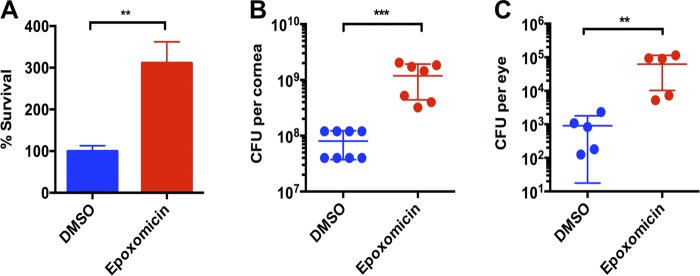Figure 6.
The physiological impact of proteasome inactivation on corneal defense against P. aeruginosa. (A) In vitro antibacterial activity. Organotypic culture of hTCEpi cells was stimulated with LTA for 16 h in the presence or absence of epoxomicin (200 nM). Cells were lysed and processed to obtain the <10-kD lysate fractions. P. aeruginosa was added to the lysate fractions and incubated for 3 h at 37°C. Viable bacteria counts were determined after incubation. (B) Ex vivo antibacterial activity. Epoxomicin (80 pmol) or vehicle control was subconjunctivally delivered and topically administered to intact mouse cornea in vivo followed by exposure to bacterial culture supernatant. Enucleated eye balls were submerged in P. aeruginosa inoculum (1011 CFU/ml) for 3 h at 35°C. After extensive rinsing with PBS, corneas were dissected and homogenized to quantify bacterial adherence. (C) In vivo bacterial clearance activity. Mice were treated with epoxomicin and bacterial culture supernatant as described in B. P. aeruginosa (107 CFUs total) was inoculated to mouse eyes in vivo. After 3 h, viable bacteria counts in the ocular surface washes were determined. Means ± SD are shown. **, P < 0.01; ***, P < 0.001. Experiments were performed three times.

